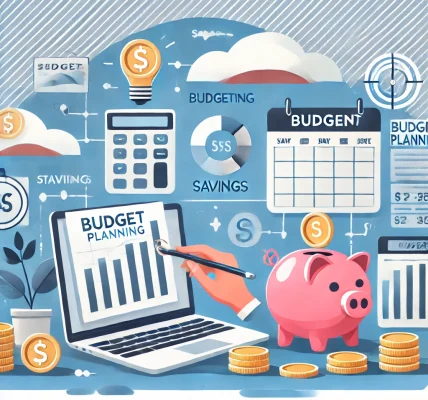Financial planning is crucial for managing money effectively, setting long-term goals, and achieving financial stability. With the rise of digital solutions, financial planning apps have become essential tools for budgeting, investment tracking, and saving. However, choosing the right app can be overwhelming. In this blog, we will explore the best financial planning apps, their features, pros and cons, and how to choose the one that best fits your needs.
Why Use a Financial Planning App?
Financial planning apps help users track expenses, create budgets, monitor investments, and plan for retirement. Here are some key benefits:
- Budgeting: Helps manage daily and monthly expenses.
- Expense Tracking: Keeps a record of spending habits.
- Investment Monitoring: Tracks stocks, mutual funds, and other assets.
- Goal Setting: Helps in saving for major expenses like a house, car, or retirement.
- Automation: Simplifies tasks like bill payments and savings transfers.
Top Financial Planning Apps for 2024
Below is a list of the best financial planning apps, carefully reviewed based on features, user experience, security, and affordability.
1. Mint
Overview: Mint is one of the most popular personal finance apps, known for its budgeting and expense-tracking capabilities.
Key Features:
- Automatic expense categorization
- Bill tracking and reminders
- Credit score monitoring
- Investment tracking
Pros: ✔ Free to use ✔ User-friendly interface ✔ Connects with multiple banks and financial institutions
Cons: ❌ Ads can be intrusive ❌ Limited investment tracking features
Best For: Budget-conscious individuals looking for an all-in-one financial tracking tool.
2. YNAB (You Need a Budget)
Overview: YNAB is designed to help users take control of their finances by prioritizing every dollar.
Key Features:
- Zero-based budgeting system
- Real-time financial tracking
- Debt repayment planning
- Financial goal setting
Pros: ✔ Helps build strong budgeting habits ✔ Provides financial education and guidance ✔ Syncs with multiple accounts securely
Cons: ❌ Subscription-based ($14.99/month or $99/year) ❌ Steeper learning curve for beginners
Best For: Those serious about budgeting and debt management.
3. Personal Capital
Overview: Personal Capital is an excellent tool for wealth management, focusing on investments and retirement planning.
Key Features:
- Net worth tracking
- Retirement planning tools
- Cash flow and spending insights
- Investment analysis with risk assessment
Pros: ✔ Ideal for tracking investments ✔ Free financial planning tools ✔ Strong security features
Cons: ❌ Premium services can be expensive ❌ Limited budgeting tools
Best For: Investors and individuals planning for long-term financial goals.
4. PocketGuard
Overview: PocketGuard helps users control spending and avoid overspending.
Key Features:
- Tracks income and expenses
- Identifies spending leaks
- Bill tracking and alerts
- Helps users determine how much they can safely spend
Pros: ✔ Easy-to-use interface ✔ Helps prevent overspending ✔ Customizable categories
Cons: ❌ Free version has limited features ❌ Some bank connections may experience issues
Best For: People who struggle with overspending and need a simple budgeting tool.
5. EveryDollar
Overview: Created by Dave Ramsey, EveryDollar follows a zero-based budgeting method to help users take control of their finances.
Key Features:
- Tracks spending and income
- Monthly budgeting templates
- Debt payoff tracking
- Syncs with bank accounts (premium version)
Pros: ✔ Encourages disciplined budgeting ✔ Simple and intuitive design ✔ Great for debt elimination strategies
Cons: ❌ Free version requires manual transaction entry ❌ Subscription required for automatic syncing
Best For: Individuals following a structured financial plan or debt payoff strategy.
How to Choose the Right Financial Planning App?
Choosing the right financial planning app depends on your needs and financial goals. Here are some factors to consider:
- Budgeting Needs: If you need help managing expenses, go for apps like Mint or YNAB.
- Investment Tracking: If your focus is on investments, Personal Capital is a great option.
- Ease of Use: If you prefer a simple and intuitive app, PocketGuard is ideal.
- Cost: Consider whether you are willing to pay for premium features or prefer free options.
- Security: Ensure the app offers strong encryption and two-factor authentication.
- Automation: Some apps allow automatic savings and bill payments, making financial management easier.
Final Thoughts
Financial planning apps can help you take control of your money, achieve savings goals, and track investments effortlessly. Whether you’re looking for a budgeting tool like YNAB, an investment tracker like Personal Capital, or an all-in-one financial management app like Mint, there’s an option tailored to your needs. Carefully evaluate the features and pricing before making a choice that aligns with your financial goals.
With the right financial planning app, you can make informed decisions, reduce financial stress, and build a secure future. Start planning today and take a step closer to financial freedom!
Disclaimer: The information provided in this blog is for educational purposes only and does not constitute financial advice. Users should conduct their own research or consult a financial professional before making any financial decisions.



